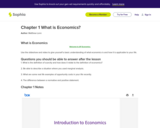
This lesson introduces subtraction operations with vectors. [3:23]
- Subject:
- Mathematics
- Material Type:
- Audio/Video
- Provider:
- Sophia Learning
- Date Added:
- 12/01/2023

This lesson introduces subtraction operations with vectors. [3:23]

This lesson introduces subtraction operations in vectors. It is 5 of 5 in the series titled "Vector Subtraction." [3:46]

This video lesson focuses on verb moods; there are three verb moods: indicative, imperative, and subjunctive. It explains each individually, discusses the verb types, articulates the tenses used for each mood, and provides examples of each mood in context. The subjunctive mood is explained the most thoroughly among all presented. [7:10]

This lesson goes over the main English verb tenses. This tutorial lesson shares a short screencast with the lesson's content. [7:41]

This lesson introduces verbs and their role in a sentence. This tutorial lesson shares a short screencast with the lesson's content. [7:10]

This lesson explains how to remember vocabulary by asking questions. This tutorial lesson shares a short screencast with the lesson's content. [4:37]

This lesson explains how to remember vocabulary by finding similar words. This tutorial lesson shares a short screencast with the lesson's content. [3:44]

This video lesson explains how to remember vocabulary by researching the meaning. [5:27] L.9-10.4c References, L.11-12.4 Word Meanings, L.11-12.4c References, L.11-12.4 Word Meanings

In this video presentation, learn the main types of legal U.S. citizenship and what it takes to be a good citizen. [15:15]

Created to teach students of the 21st century, SOPHIA is bringing the concept of empirical questions straight to your fingertips within this interactive lesson. [13:36]

Introduction to economics using notes and a corresponding video teaches students the basic definition of economics which involves individual choice. [1:12]

A screencast lesson reviewing the proper usage of the subject form who and the object from whom with examples of how to use each word correctly. [2:26]

This lesson focuses on determining the correct meaning of a word with multiple meanings. First it explains why words in English have multiple meanings. Then using the word "bear," it provides steps and examples for how to determine the correct meaning based on its use in the sentence and context clues. It also shows how to use dictionary.com to help determine which meaning is correct. [9:11] L.9-10.4d Verify meaning. CCSS.ELA-Literacy.CCRA.L.4, L.11-12.4 Word Meanings, L.11-12.4d Verify meaning

This tutorial focuses on using APA Style for research papers including the formating, documentation, and reasons for using it. It offers a YouTube video for finding the APA format template in Microsoft Word 2007 and information for creating a defined style on earlier versions of MS Word. It also provides a 37-page slide show of the "Purdue OWL APA Formating and Style Guide." The guide covers formating, style, headings, figures, in-text citations, and reference pages. Links are provided to other resources as well.

This lesson goes over how to summarize a source for an annotated bibliography. This tutorial lesson shares a short screencast [4:16] with the lesson's content. [4:16]

This lesson goes over how to summarize a source for an annotated bibliography. This tutorial lesson shares a short screencast with the lesson's content. [2:59]

This video lesson focuses on writing conclusions, i.e., what makes an effective conclusion, what to include in a conclusion, and how to write one. [7:44] W.9-10.1e, W.9-10.3e Conclusion, W.11-12.1e Argument Conclusion, W.11-12.2f Conclusion, W.11-12.2f Conclusion, W.11-12.3e Narrative Conclusion

A screencast lesson discussing and providing examples of three elements required for a strong introduction: an effective hook, a strong thesis, and appropriate background information. [5:39] CCSS.ELA-Literacy.WHST.6-8.2

Explains what equivalent equations are and how to find out if two equations are equivalent. The video is accompanied by a downloadable transcript and quiz questions. [7:57]

In this lesson, students see how to write a summary based on a set of data. It is 1 of 6 in the series titled "Writing a Data Summary." Includes short quiz. [4:18]